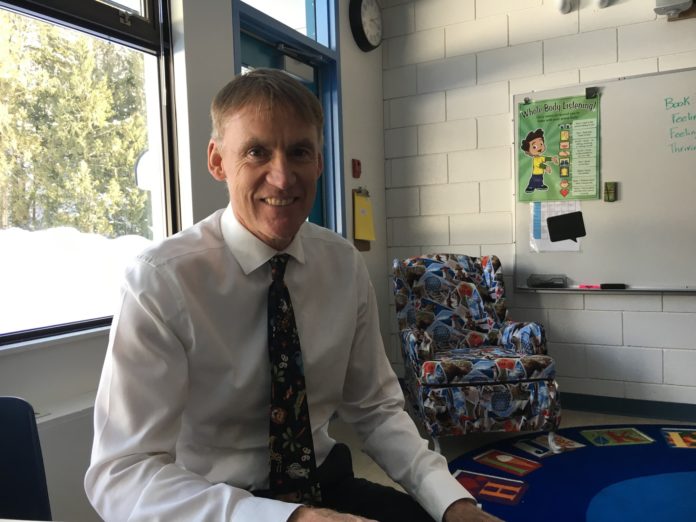We as a society know the dangers of fentanyl, yet those addicted to drugs and those who use them recreationally still do them. Sobriety is not an easy road to go down; it is daunting, heartbreaking and gut-wrenching for those that suffer with addiction. Short of not doing drugs all together, fighting for sobriety is the safest way to stay alive.
Wit Fentanyl a hot topic for discussion, harsh judgments are directed towards those that consume the drugs and those that are here to protect us from those that sell them. While that is not as easy to break down as one would think, we still have to overly educate to ensure the youth of today are not taking a very dangerous risk. While the Provincial and Federal Government are steadily producing Public Service Announcements in regards to this deadly drug, not everyone is hearing the message.
Kids today are no different than the kids of yesterday. They may be bright, driven and ambitious, however when you are young, there is an element of invincibility. Every adult once experienced it during their heyday. How do we reach those kids in our community that are getting to an age where curiosity is at its peak and temptation may be presented before them? How do we save them before they fall?
School District 19 is taking this matter very seriously. The administration is very well aware of the patterns of youth and knows when it is time to educate kids on the realities of the dark corners of society. There is a regular roundtable meeting with SD19, RCMP, BC Ambulance, Queen Victoria Hospital, local physicians, Clinical Counsellors, Community Connections, the Women’s Shelter and the City of Revelstoke that is dubbed the Child and Youth Mental Health and Substance Use Local Action Team (CYMHSU). The sole purpose of this group is to align accurate, research-based information with education and intervention.
Who do people do drugs? Why would a student risk their lives by ingesting something that could potentially end their life? The CYMHSU is looking at that exact question. Problematic drug use is often associated with unresolved mental health concerns, grief, loss or trauma. Their focus is on enhancing the belonging and connectedness of each student, as healthy adult and peer connections are key to a student’s self-worth, belonging and value.

A sense of increased personal self-knowledge and understanding is essential in the development of informed decision making. Understanding of one’s self is crucial in childhood development and having that respect and personal knowledge can open the doors to making informed decisions and understanding the consequences of their actions. In an information release from the CYMHSU states, “It is not enough to tell youth about the dangers of drugs, and tell them “just say no”. Brain development research is clear – youth are more inclined to take risks and to seek sensation. The key is to help them understand themselves, to build trust with them as caring adults, and to come alongside them to help them make informed, safe decisions.”
There is a parent-participation series in Grade 5 classrooms called Parents as Ultimate Supporters and Educators for Mental Health (PAUSE) in which the main focus is to start the conversation at an earlier age to understand the value of positive and safe decision making. Teaching the young ones about the power of positivity, self-worth and informed decision making about any aspect in one’s life, can result in the child having the wherewithal to stop and think before they do. As kids get older, they take more risks and can defy authority on their own principals of thinking they have all the answers. What are the students taught in Revelstoke?
Starting in grade 4 and stretching to grade 12, Physical and Health Education classes are where students are taught about the physical, emotional, and social aspects of psychoactive substance use and potentially addictive behaviours as well as how to assess strategies for managing problems related to mental well-being and substance use.
According to the CYMHSU report, the more preventative aspects within the curriculum are the core competencies that are taught; critical thinking, communication skills, cultural identity, personal awareness and social responsibility.
On Tuesday, February 20th -24 grade 5 students from Arrow Heights Elementary took part of PAUSE in which the kids were broken up into groups alongside a parent or guardian and were placed in a rotation of workshop spaces. The PAUSE session is one in a series.
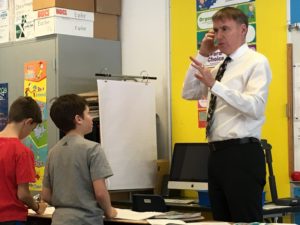
Superintendent Mike Hooker, was hosting the “I am Grateful For” section in which Hooker spoke to the students about the right creative (and connected to emotions) side of the brain and the left analytical side of the brain and how to regularly exercise both sides for a healthy balance. With the simple motion of playing Crossover, although it may seem silly and that it is not doing much, it keeps the brain active as it needs to recognize opposition and the more exercise a brain has, the better chance for positive thinking.
When asked why grade 5? Hooker told the Revelstoke Current, 10-11 year olds are a great connection age, they are more open to taking to parents and teachers and they are at the point where they can share more definitively, how they feel.”
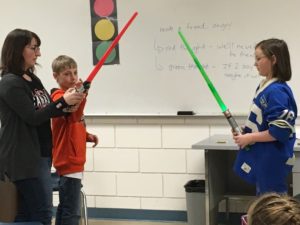
AHE Principal, Rita Tedesco’s workshop was also about the power of positivity, and that it is much easier to be in the negative, so we need to work at seeking positive situations, scenarios and responses. In an effort to make it fun, Tedesco used two Star Wars-Light Sabers in which the red was negative and the green as positive. The students were to be matched up with both other students and their parents to understand just how hard it is to be positive at times, and it does take critical thinking. The student holding the red Light Saber was to say something negative “I am not going to do well on this test” and the student holding the green Light Saber was to respond to the negative with a clear line of positivity, “You studied all week. You will be great.”
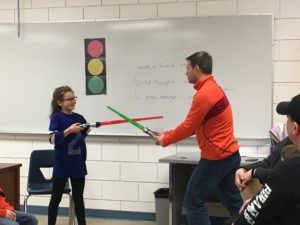
It wasn’t just the students that took a few milli-seconds to respond in a positive fashion. It was a good exercise to remind us that it is easy to be in the negative and remaining positive does take effort.
District Principal, Ariel McDowell had a semi-circle of students in which she used an Aboriginal Medicine Wheel to explain to kids that then ‘pie chart’ represented 4 timelines of life; Beginning stage (baby), Growing/Learning Stage(Student-Youth), Providing Stage (Adult-Parent), Senior Stage (Retirement-Grandparent). This was to get the children to think of those that are important, what they represent to them and better yet, who is in their support system to guide them through hard decisions.
“Research is pointed to trusted and caring adults and on open lines of communications of parents and teachers- that is paramount.” Hooker stated.
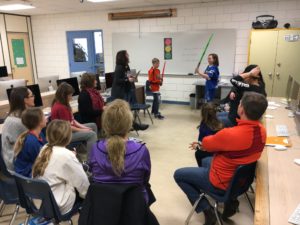
The Provincial Curriculum has education for students when they take Physical Education. In terms of the bread and butter of information, Hooker explains that it is implemented, but it is time to think outside of the information box that we all recall from our years in school. Telling a student that drugs and alcohol is bad for them, that it can be harmful, is falling on deaf ears. RSS has had guest speakers come in to speech to their addiction or past behaviour, but the message doesn’t always land on the students it should.
“It is about 50/50 on guest speakers. The kids that are already hardwired not to fall into that trap-it just reinforces their decision not to. It is that age. We were all like it once, where we know everything and no adult can tell us. That is where it is hard to break through.”
While the curriculum does explain the dire straits of drugs and alcohol to students, that fentanyl is deadly, many students carry that attitude of invincibility that seems to be passed down universally from generation to generation.
This is why grade 5.
“It is all about protective factors. The more kids feel connected, the better they feel.”
Social Development Coordinator, Jill Zacharias recently conducted a drugs and alcohol survey with 300 of the 360 students of RSS. The results of the survey will be finalized in the next short while.
For more information on mental health services in Revelstoke visit https://revelstokecymhsu.wordpress.com/

